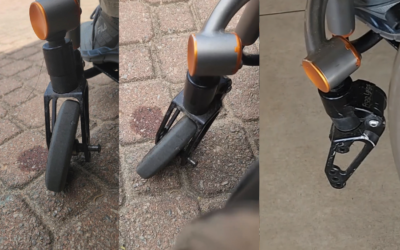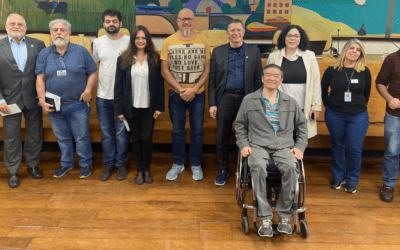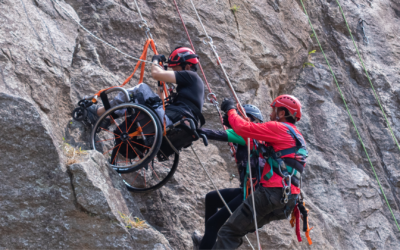
Sounding off on the air travel challenges faced by deaf and hard of hearing passengers
There are 48 million deaf and hard of hearing people in the USA, and a total of 642 million globally. Combined with people with other disabilities these potential passengers make up the world’s largest minority market with a size equivalent to that of the population of China.
Last year, I gave a presentation to the New York City User Experience Professionals Association. During the Q&A segment an attendee who was using Communication Access Real-Time Translation (CART) – also known as real-time captioning – challenged me to explain why the aviation industry had ignored the needs of deaf and hard of hearing passengers, including providing closed captioning for inflight entertainment.
Svetlana Kouznetsova is a web and usability experience specialist with an interest in accessibility. Born with normal hearing, Kouznetsova became profoundly deaf in both ears at the age of two due to Meningitis. She is bilingual in Russian and English and uses lip-reading, writing/typing, and/or sign language to communicate with people depending on the situation and whom she talks with.
“Being a deaf/hard of hearing traveller is very frustrating – especially when travelling alone. There seems to be less understanding about deaf/hard of hearing travellers than those with other disabilities. Every time you inform crewmembers that you are deaf, many of them either hand you a wheelchair or a Braille print without understanding that you need visual access to aural information”, explains Kouznetsova.
The Air Carrier Access Act of 1986 (ACAA) prohibits commercial airlines from discriminating against passengers with disabilities and requires deaf and hard of hearing individuals to self-identify in order to receive accessible information. But Kouznetsova says, “This is not enough”. The US National Association of the Deaf agrees, saying, “Self-identification is not an effective means of obtaining accessible information, because information is provided in multiple locations by different people. Instead, all audible information should be routinely made accessible visually.”
I asked Kouznetsova to verbally walk me through a typical journey for her and identify the areas where there is room for improvement. She says, “When checking airline websites for information about accessibility for passengers with disabilities, I notice that most of them focus in detail on passengers with physical disabilities, and very little or nothing is said about deaf/hard of hearing passengers.”
“To avoid problems whenever possible I try to take a direct flight and pack light. If I check in a bag, I let the agent know that I’m deaf to make them aware when communicating with me. They issue me a boarding pass with a luggage ticket and write down the gate number and sometimes directions to the gate if I am not familiar with an airport.”
“Once I am at a gate, I inform the gate agent that I am deaf and ask them to inform me of any aural announcements. However, I have to remind them many times, and it’s one of the most frustrating parts of my travels. One time I almost missed my flight because I was not aware of a gate change. It would be good for all gates to have a display that would show captions every time an agent makes an aural announcement.”
“When I board, I show a written note to a flight attendant that I am deaf and ask them to let me know of any aural announcements in writing. Most attendants are accommodating, but there have been times when crew have forgotten to assist me or offered me the wrong type of support. Once a flight attendant (who I had already informed I was deaf) forgot to let me know that we were about to land – I was sleeping at that time, with my lap belt unbuckled (something that an attendant should have noticed) and woke up when I felt the plane touch down!
“Many airlines do not provide captioned inflight entertainment – which is the major complaint of deaf and hard of hearing travelers. During my recent transatlantic flights I saw only a few subtitled foreign movies, but 50-plus other movies and shows were not captioned. Yet, they had soundtracks in additional spoken languages.”
“When I have to transfer I ask for airport disability assistants to guide me from one gate to another to avoid issues with asking for verbal directions and missing the next flight. My requests were never fulfilled for domestic flights in the USA, and I was better accommodated during international flights when attendants called airports in advance for an assistant. Even then I had to remind flight attendants and to make sure to repeat that I did not need a wheelchair, just someone to guide me through a complex airport.”
In closing our interview Kouznetsova says, “I know that it is a lot to ask, but since deaf/hard of hearing travelers pay the same price for flights, they deserve the same access as other travelers. Besides, we live in the 21st century with advanced technologies that make accessibility to audio via text possible.”
Yesterday, news emerged that US Senator Tom Harkin has introduced a bill that would require captioning and video descriptions on IFE, and movie theaters. So progress is being made…albeit slowly.
Source: apex
Compartilhe
Use os ícones flutuantes na borda lateral esquerda desta página
Siga-nos!
Envolva-se em nosso conteúdo, seus comentários são bem-vindos!
Artigos relacionados
Rodinha dianteira quebrada. Como lidar com um pronto socorro.
Rodinha dianteira quebrada. Imprevistos podem acontecer a qualquer hora em qualquer lugar, por isso o mais importante é saber lidar com eles.
Turismo acessível na política. Comissão do Turismo destaca a importância da acessibilidade.
Turismo acessível na política da Câmara Municipal de SP. Comissão do Turismo destaca a importância da acessibilidade para as PcD.
Teleton AACD. A pessoa com deficiência como protagonista.
Teleton AACD. A pessoa com deficiência como protagonista. Uma iniciativa internacional abraçada pelo SBT no Brasil.






0 comentários